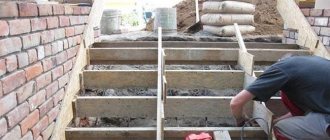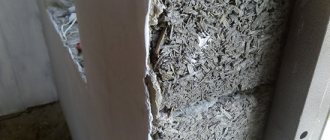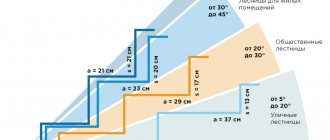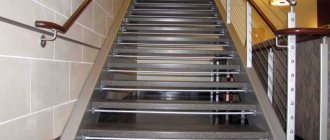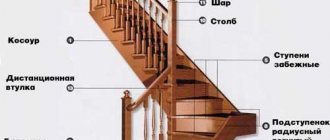When designing a staircase, two things are simultaneously taken into account: the convenience (safety) of moving along the stairs and minimizing the space occupied by the staircase. The safety of the stairs depends on its slope and the parameters of the steps.
In order to correctly design a staircase, it is necessary not only to choose its location wisely, but also to take into account the staircase design standards set out in the relevant chapters of SNiP.
The following are the basic norms, rules and requirements that must be taken into account when designing and constructing stairs.
The width of such stairs must be at least 0.8 m, and the width of the solid treads of their steps must be at least 0.2 m.
8.1.1. The number of ascents in one flight between platforms (except for curved stairs) must be no less than 3 and no more than 16. In single-flight stairs, as well as in one flight of two- and three-flight stairs within the first floor, no more than 18 ascents are allowed.
8.1.2. Flights of stairs and landings must have fences with handrails.
8.1.3. In front of the outer door (emergency exit) there must be a horizontal entrance area with a depth of at least 1.5 times the width of the outer door leaf.
External stairs (or parts thereof) and platforms with a height of more than 0.45 m from the sidewalk level at entrances to buildings, depending on the purpose and local conditions, must have fencing.
8.1.4. The slope of staircases in above-ground floors should be no more than 1:2.
The slope of flights of stairs leading to the basement and ground floors, to the attic, as well as stairs in above-ground floors not intended for evacuation of people, is allowed to be 1: 1.5.
The slope of ramps on the routes of movement of people should be no more than:
Note - The requirements of this clause and clause 8.1.1 do not apply to the design of passages with steps between rows of seats in auditoriums, gyms and auditoriums.
8.1.5. The width of a flight of stairs in buildings must be no less than the width of the exit to the staircase from the most populated floor, but not less than m:
1.35 - for buildings with more than 200 people staying on the most populated floor;
1.2 - for other buildings;
0.9 - in all buildings leading to a room with up to 5 people simultaneously staying in it.
The intermediate platform in a straight flight of stairs must have a depth of at least 1 m.
The width of landings must be no less than the width of the flight.
8.1.6. In staircases intended for the evacuation of people both from above-ground floors and from the basement or ground floor, separate exits to the outside from the basement or ground floor should be provided, separated to the height of one floor by a blind fire partition of the 1st type.
8.1.7. Separate staircases for communication between the basement or ground floor and the first floor leading to the corridor, hall or lobby of the first floor are not taken into account when calculating the evacuation of people from the basement or ground floor.
8.1.8. If a staircase from the basement or ground floor opens into a ground floor lobby, then all stairs in the above-ground part of the building, except for the exit to this lobby, must have direct access to the outside.
8.1.9. As a rule, spiral staircases and winder steps, as well as split landings, should not be provided on escape routes. When constructing curved staircases leading from service premises with the number of people permanently staying in them no more than 5 people, as well as curved main staircases, the width of the steps in the narrow part of these staircases must be at least 0.22 m, and for service staircases - at least 0 ,12 m.
8.1.10. In the IV climatic region and in the IIIB climatic subregion, the construction of evacuation external open staircases is allowed.
8.1.11. Each floor of the building must have at least 2 emergency exits.
8.1.12. The width of evacuation exits from premises and buildings must be at least 1.2 m when the number of evacuees is more than 50 people.
8.1.13. The clear width of horizontal sections of escape routes and ramps must be at least 1.2 m for common corridors along which more than 50 people can be evacuated from premises.
8.1.14. As the second, third and subsequent emergency exits from the second floor of buildings (except for school buildings and boarding schools) in all climatic regions, it is allowed to use external open stairs with a slope of no more than 60°. In this case, these stairs must be designed for the number of evacuees no more than:
70 - for buildings of I and II degrees of fire resistance;
50 - for buildings of III degree of fire resistance;
30 - for buildings of IV and V degrees of fire resistance.
The width of such stairs must be at least 0.8 m, and the width of the solid treads of their steps must be at least 0.2 m.
The paragraph was deleted as of February 1, 2011. — Change No. 1, approved. Order of the Ministry of Emergency Situations of Russia dated December 9, 2010 N 639.
8.1.15. Staircases should be designed with natural light through openings in the external walls (except for basement stairs).
In no more than 50% of the stairwells of 2-story buildings of fire resistance degrees I and II, as well as 3-story buildings, when a clearance between flights of stairs is at least 1.5 m, only overhead lighting can be provided.
when installing automatic fire extinguishing throughout the entire building;
in buildings with a height of no more than 9 m and a floor area of no more than 300 sq. m.
8.1.17. From the premises, regardless of their purpose (except for storerooms of flammable materials and workshops), one of the exits can be directly to the vestibule, dressing room, floor hall and foyer adjacent to the open staircases.
8.1.18. External fire escapes should be located at a distance between them of no more than 150 m along the perimeter of buildings (except for the main facade).
8.1.19. The width of the emergency exit from the corridor to the stairwell, as well as the width of the flights of stairs, should be set depending on the number of evacuees through this exit based on 1 m of exit (door) width in buildings of fire hazard classes:
8.1.20. The greatest distance from any point in halls of various sizes without seats for spectators (waiting rooms for visitors, ticket offices, rest areas, etc.) to the nearest emergency exit should be taken according to Table 23. When combining the main evacuation passages into a common passage, its width should not be less than the total width of the combined passages.
The figure below shows a comfortable human step and the recommended width and height of the steps.
- Services
- Prices
- SNiPs/GOSTs
- Gallery
- Articles
Articles:
- Furniture and assembly
- Repair and interior
- PUE and electrical
- Style and design
- Plumbing
- Materials
- Expertise
- Documentation
- GOSTs and SNiPs
- Doors and windows
- Feng Shui in the home
SNiP requirements for step sizes
Accurate calculation - half the job is done!
Now we will analyze in detail the main component of a flight of stairs - steps. As stated above, SNiP prescribes a maximum number of steps of no more than 18. In a span, steps have different names depending on location:
- The lower frieze is the very first step of the flight from the floor. It rises above the floor to the height of its riser.
- Ordinary steps.
- Upper frieze - steps in front of the landing or steps leaving a flight of stairs. Must be level with the floor of the second floor.
As you can see, there are three positions in the list: bottom step, ordinary and top. This is the minimum number of steps in one flight - three. As for the width of the flight of stairs, it depends on the width of the steps. The rules here also prescribe the minimum and maximum width for stairs for different purposes:
| street stairs | 80 cm; |
| internal straight staircase in the apartment | 80 cm; |
| internal spiral in the apartment | 80 cm – 1 m; |
| internal to the attic | 60 cm; |
| internal to the basement | 80 cm; |
| escape (fire) staircase | 80 cm. |
Minimum and maximum dimensions of steps and risers
Based on practical experience, it has been established that the most comfortable stairs are those with two riser heights plus tread width equal to the average human step. The average length of a human step is approximately 60 centimeters.
If we put this in the form of a formula, we get 2h + b = S (60-66 cm) (Blondel's formula, 17th century). There are two more rules for calculating optimal sizes:
- “convenience formula”: b - h = 12. This means the ratio of the width of the tread to the height of the riser. Subtracting the height of the riser from the width of the tread, we get twelve in the remainder.
- “safety formula”: b + h = 46.
What does SNiP prescribe? It stipulates the minimum and maximum dimensions of the tread and riser. The height of the step should be from 150 to 200 millimeters. In this case, fluctuations in the size of the riser are allowed, but not more than five millimeters. The minimum tread width is 250 millimeters. For attic/basement stairs - 200 millimeters. Winder steps in their middle part should not be less than 250 millimeters.
The table shows the ratio of tread (b) to riser (h) in two dimensional situations:
| b/h | 30/15 | 31/16 | 29/17 | 28/17,5 |
| Slope, ◦ | 26,6 | 27,4 | 30,5 | 32,0 |
| b/h | 27/18 | 26/19 | 23/20 | 21/21 |
| Slope,◦ | 33,7 | 36,3 | 41,0 | 45 |
The figure below shows a comfortable human step and the recommended width and height of the steps.
All steps are twin brothers!
You may ask, why do you need the edge of the tread to overhang? This is done in cases where it is impossible to design its optimal width (the staircase is too steep, there is not enough allocated space). Then, using this technique, the treads are expanded at least slightly.
Advice:
In such cases, experts advise not to cheat and not cut out millimeters at the risk of human safety, but simply design “duck step” steps (read about them in one of our previous articles).
The lighting requirements for the main structures must also be observed. SNiP require high-quality illumination of steps, especially the first and last elements of the flight. If there are window openings (according to GOST, if they are located at the height of an adult), they must be fenced.
Basic regulatory documents for various types of stairs
When designing, it is recommended to rely on the following SNiPs:
- II-23-81 – steel objects;
- II-25-80 – wooden objects;
- 35-01 2001 - objects with ramps for the disabled;
- 2.01.07-85 - describes the permissible loads on all staircase elements;
- 2.08.01-89 - design of residential buildings;
- 2.08.02-89 - design of public buildings.
Why it is so important to adhere to the recommended standards and rules when designing stair elements is described in the video below.
This standard applies to steel flight stairs, platforms and their fencing used in industrial buildings and structures constructed and operated at temperatures not higher than plus 100°C and not lower than minus 60°C.
Types of steps
There are several types of classification of stages.
According to their plan form, the steps are divided into:
- ordinary , having a rectangular shape in plan. Such steps are used in staircases;
- winders , complex shapes, allow you to create spiral and curved staircases.
Combinations of ordinary and winder steps form combined stairs.
The second type of classification is based on the presence of risers. The riser is the vertical plane of the step. The horizontal surface on which the foot rests during lifting is called the tread.
There are three types of steps:
- open without risers. the most common stairs with such a step are made of wood and metal;
- closed with risers. Such steps can be found on any staircase of an apartment building;
- half- closed The riser of such a step only partially covers the gap between the treads.
FAST
SEO optimization
Adaptive layout
Repair in the regions
- home
- Construction
- Types of stairs in a private house
- Number of steps in a march
The maximum number of steps in a flight is 18 (including the frieze step); The desired number of steps should be considered 15 (no more than 16)
The minimum number of steps in a flight is 5. The width of the flights depends on the required capacity of the stairs, determined by the number of people who can pass through the narrowest point of the stairs within one minute. In residential buildings, the number of people is calculated by the usable living area (at a rate of 9 m per person) per staircase.
The number of steps in a flight at various slopes and rational heights of ascent in one flight (with standard steps)
If there is direct access to several staircases, the maximum number of people, by which the width of the flights is determined, is distributed over all staircases, with the exception of one (assuming that one staircase cannot be used for evacuation).
The width of flights of stairs: for main staircases - at least 1.32 m, for service ones - at least 1.10 m, for attic, basement and external ones - at least 0.75 m.
The width of the platforms is not less than the width of the flights adjacent to the platform; in the presence of elevators - at least 1.8 m. The height of the passage between the platforms is assumed to be 2.1 m; with a design height of the site of about 0.4 m - 2.5 m, the height of the passage to the attic and basement is at least 1.9 liters.
When designing a staircase, we calculate the steps
A flight of stairs measuring 100 cm will be much more convenient for moving in a spiral.
Step sizes
As already mentioned , the best combination would be a riser height of 15 and a tread width of 30 centimeters. Regulatory documents allow the use of steps with other sizes that satisfy the conditions of safe operation.
It is most convenient to use steps with standard sizes. This will significantly reduce the cost of the design and facilitate installation. Non-standard steps should be considered only in cases where standard materials are absolutely inapplicable.
When making stairs from reinforced concrete, you can choose the already known dimensions of the step or step with a height of 17 and a width of 26 centimeters. Among specialists, such steps are called “basement”. They are less convenient due to their greater height, but are more compact. Reinforced concrete steps are produced in series and have a standard length.
Steps with a width of 30 centimeters are available in lengths of 0.9, 1.05, 1.2, 1.35, 1.5, 1.65 and 2.25 meters. Basement steps can be 0.9, 1.05 or 1.2 meters long. Precast concrete factories can produce products according to customer sizes, but this will be very expensive.
When making stairs from wood or metal, it is much easier to deviate from the GOST dimensions.
The size of wooden steps can only be limited by the size of the raw materials. Most manufacturers can make steps from 90 cm to 5 m long. The width of the product can range from 20 cm to 2 m. The size step in plan is 10 cm. The thickness of the board is offered in 2, 3 or 4 cm.
Stairs made from unpopular materials, such as triplex glass, are made to individual sizes.
Standards and requirements for flights of stairs
The main norms and standards are the following documents, based on which the project is developed and the width of the march is determined:
- SNiP 21-01-97 – Fire safety of buildings and structures.
- GOST 23120-78 – Flight stairs, platforms and steel fences. Technical conditions.
- GOST 8556-72 – Manual wooden fire ladders. Technical conditions.
- GOST 53254-2009 – Fire fighting equipment. External stationary fire ladders. Roof fencing. General technical requirements. Test methods.
These documents regulate the minimum width of a flight of stairs for different types of stairs. The maximum width of the march is not limited, subject to compliance with all safety standards, such as:
- the presence of handrails;
- arrangement of ramps;
- compliance of step sizes with generally accepted standards;
- maintaining the correct angle of inclination of the stairs depending on the installation location.
Determination of the height of steps during design is also provided for by GOST and SNiP. The comfortable height for this project is calculated using the following methods:
Reliability and compliance with the rules for installing stairs is the key to safety
In the design of premises and buildings, stairs play a huge role both visually and functionally, so such structures, especially those intended for general purpose buildings, are subject to quite serious requirements when developing a project.
Due to the fact that in such places there is a colossal load on the staircase structure (trade pavilions, exhibition halls, residential buildings, buildings of higher educational institutions, hospitals, restaurants, etc.), the requirements for stairs and landings must be calculated taking into account the expected maximum loads.
Their structure, the materials that are used for their environment (outside or inside public buildings), various other parameters for each type of building and stairs must be distinguished.
Intricately crafted spiral staircase
Standard requirements for the construction of stairs in public buildings
Stairs in buildings are always a risk area due to the design itself, therefore, when developing and designing it, absolutely all factors should be taken into account, even minor ones, for example, if the stairs will be used by children.
Here you should consider both staircase openings and the degree of illumination from natural and artificial sources.
The designer’s task is to identify the shape, slope, and size of steps that are as close as possible to the comfort and design of the customer, taking into account the material from which the staircase is planned to be made, and, when calculating the design of the staircase in accordance with its purpose, adhere to SNiP and GOST standards for the selected type.
If in the construction of buildings according to personal projects for private houses, small deviations from the norms are allowed due to the relatively small load, then for the design and construction of stairs in public buildings, compliance with standards, GOSTs and SNiPs is mandatory, otherwise such a structure is simply unacceptable for use.
Classification of staircases and their tasks
Let us first consider the classification of ladders according to the purpose and tasks that various ladders perform.
The primary task is to organize convenient access to the premises by equipping the floors of multi-storey buildings with staircases. They usually have elevators, but stairs are needed in case the elevator is busy or malfunctioning. The staircase must provide basic movement between floors, and its width and height must be built to parameters that will allow the movement of a large number of people, large furniture and other cargo. The main staircase should solve this problem in the building.
The existing other types of stairs solve many equally important problems, so let’s take a closer look at them.
Regular staircase around an elevator shaft
Secondary staircases in general premises
An auxiliary staircase is a structure intended for technical, auxiliary premises. This includes storage rooms, attics, basements, etc.
A service staircase is a structure intended only for employees (in hospitals, maternity hospitals, trading floors, cultural and city service buildings, production buildings, factory workshops, sports stadiums, etc.). This staff staircase is small in size and allows a small number of people to move around.
An emergency staircase (emergency, evacuation) is a structural element that can be located both inside the building and outside. In the event of a natural disaster or fire, such a staircase must ensure the evacuation of people if the main staircase is inaccessible for any reason.
A fire escape is a structure leading to the roof of a building; it is intended for use by firefighters, sometimes it is an additional means. If an inclined staircase creates a structural obstacle, you can make it vertical in compliance with all rules for access and safety, that is, preserving its intended purpose.
A properly constructed escape ladder
Requirements for the arrangement of staircases in public buildings
Designers who develop the appearance, taking into account the practicality of structural elements inside the room, as well as builders of two-level apartments, multi-level floors in offices, must take into account the placement of stairs, their type and type, even before starting work, in order to correctly calculate all the loads and complete the project taking into account all the details .
Here you need to calculate in advance how to attach stairs to walls or other load-bearing structures, make the correct dimensions of the openings and determine their location in the floors between floors.
This also includes the basic requirements for regulatory documents regarding the slope, parameters of the width of flights, connecting platforms, and the number of steps in one flight.
FAQ
Do you need an emergency exit ladder on the balcony?
- Yes, if they already exist.
Is it possible to remove (cut, saw down, dismantle) the emergency exit ladder from the balcony (loggia), and what is the fine for this?
- The question already has an answer - it’s impossible. Whether the owner can be fined for this is a difficult question in practice. But the management company, on its own initiative, or rather on the orders of the federal fire inspector, will certainly find leverage to force the apartment owner to restore this emergency exit, which is needed not only by him and his family members, but also by the neighbors below and above. In difficult cases, they will be forced to do this by court decision.
What is the difference between a fire escape and an escape escape?
— Maximum permitted slope and width. For a fire escape it is 1:6 and 0.6 m, and for an emergency escape it is 1:2 and 0.9 m.
Tests
Testing of internal staircases of buildings, structures used for evacuation, and those made of reinforced concrete structures is usually carried out by accredited construction control laboratories for signs of loss of integrity, changes in geometric dimensions, and loss of load-bearing capacity.
Such cases do not occur very often in practice, but they do occur. Much more often it is necessary to test internal and external evacuation stairs made of steel structures. The former also check for the safety of the layer of fire-retardant plaster, other fire-resistant coatings, and paints.
The greatest interest among readers, including property owners and management of enterprises (organizations), is the need to check the external evacuation stairs of buildings.
GOST R 53254-2009, which regulates testing methods for external stationary fire escapes, in paragraph 1.1 directly states that its requirements apply to vertical and flight fire escapes, including evacuation and emergency exits, installed outside public, residential, and industrial protection facilities.
Therefore, assurances that there are requirements of fire safety standards to check only external fire escapes, but not evacuation staircases, are groundless. It is also worth noting that external stairs at emergency exits include stairs on loggias and balconies of multi-storey residential buildings, which are also subject to regular testing.
Frequency of inspection of external evacuation stairs according to GOST R 53254-2009:
- during the commissioning of buildings and structures;
- at least once a year, an inspection of the integrity of metal structures, drawing up a report on this event;
- periodic tests at least once every five years, based on the results of which a protocol should be drawn up, the form of which is given in this standard.
To conduct tests of both external fire escape and escape stairs, a license from the Russian Ministry of Emergency Situations is not required, but trained personnel are required, as well as a material and technical base - certified testing equipment, a set of proven measuring instruments.
In practice, such tests are mainly carried out by the same specialized organizations that perform work across the entire range of firefighting services, including within the framework of contractual relations for firefighting outsourcing.
Parameters of railings (fences)
- The height of the railings of interfloor stairs must be at least 90 cm, for stairs with a height of more than 12 m - 110 cm.
- For stairs used by children, the recommended height of the railings is 150 cm.
- The height of the railings of external entrance stairs when climbing 3 or more steps must be at least 80 cm.
- Stairs with more than 5 steps, with a flight width of up to 125 cm, are equipped with a handrail on one side, with a flight width of 125 - 250 cm on both sides. Flights of stairs wider than 250 cm are equipped with additional railings in the center of the flight.
- The absence of guardrails is acceptable for stairs of 5 steps or less.
- The distance between balusters (railing posts) should not be more than 12 cm when the height of the stairs from the floor is over 150 cm.
- The stair railings must withstand a load of 100 kg/m.
All steps are twin brothers!
The height of the risers and the width of all steps must be strictly the same. Imagine yourself walking down a flight of stairs in the dark. As you lower your foot onto the next step, you automatically, involuntarily begin to place your foot at the same distance as in the previous step. That is, the muscle memory of your legs, guiding them, implies the same height of the steps. And if their heights turn out to be different, then on some steps you involuntarily press your foot into the tread, while on others you cannot reach the support. In other words, the rhythm of the descent is disrupted and you, like a disabled person, are forced to fumble with your foot for each next step. The same can be said about the rhythm of forward movement (tread width). For a continuous smooth ascent/descent, a clear rhythm is needed - the same width of all steps of the march.
The width of the tread should be such that a person’s foot can fully stand on it, that is, 300-320 millimeters. Regarding the riser: its optimal height is 150 millimeters. If the comfortable width and height are violated, then this threatens troubles, the least of which will be difficult ascent, and the more serious - a traumatic descent. Speaking about winder steps, you need to know that the width of the tread at its narrow end should not be less than 100 millimeters, and the overhang of its edge over the lower tread is not allowed to exceed 50 millimeters. For wooden stairs, the permitted overhang is 30 millimeters, and for metal stairs - 50 millimeters.
You may ask, why do you need the edge of the tread to overhang? This is done in cases where it is impossible to design its optimal width (the staircase is too steep, there is not enough allocated space). Then, using this technique, the treads are expanded at least slightly.
Advice:
In such cases, experts advise not to cheat and not cut out millimeters at the risk of human safety, but simply design “duck step” steps (read about them in one of our previous articles).
So, we once again turned to the topic of calculations and parameters of a flight of stairs. By reading our portal, you will become a knowledgeable person in the field of staircase construction. We will know not only general facts, but also the requirements of SNiP. By the way, remembering the basic numbers regarding stairs is not at all difficult. But you will be able to clearly voice the necessary parameters when it comes to designing stairs, without wasting time studying multi-page instructions. For reinforcement and clarity, watch a useful video on how to design stairs in a computer program. Good luck to you and we look forward to your responses!



